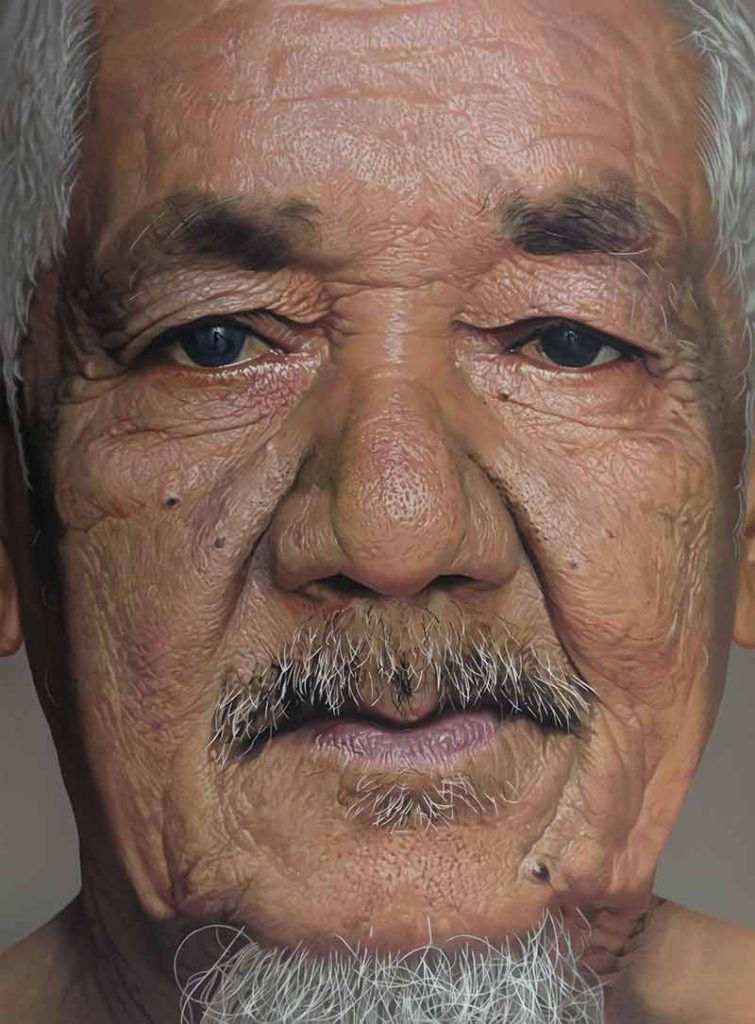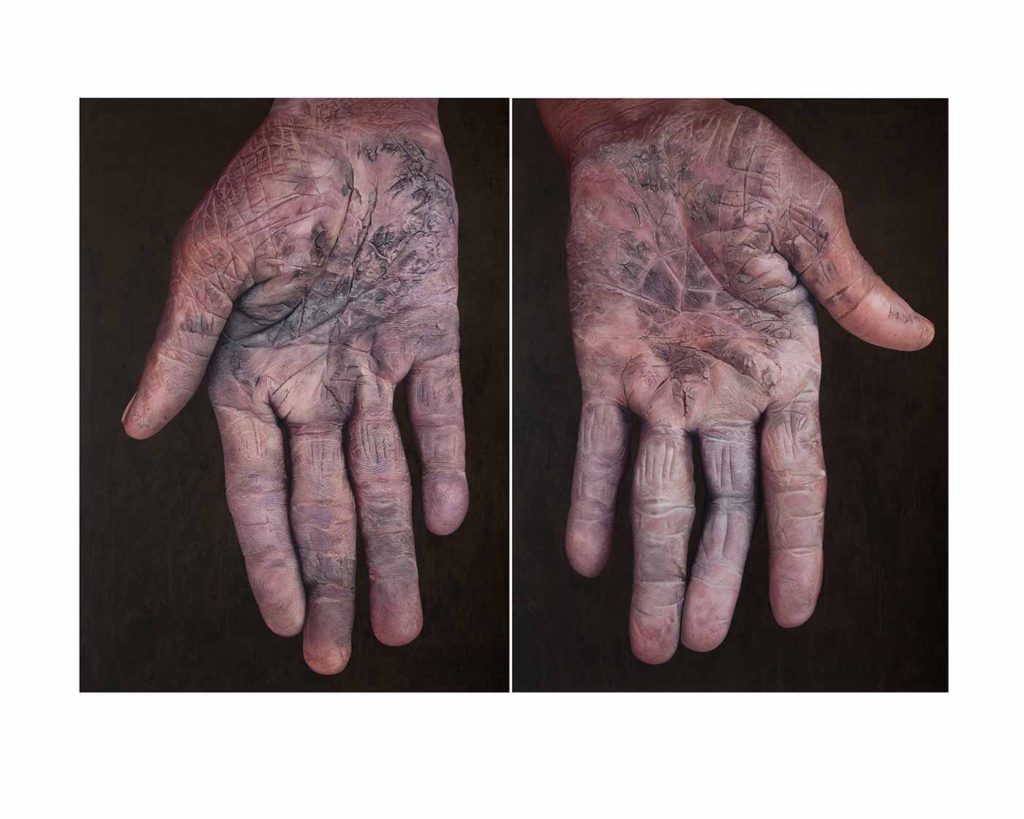Contemporary artist Parag Sonarghare expresses himself via hyperrealism, while he strives to be technically perfect with his medium.
Through my work, I hope to go beyond the static image and into the realm of an experience that is both familiar and altered.
Contemporary artist Parag Sonarghare

Artist portrait courtesy Contemporary artist Parag Sonarghare.
Please tell us a little about yourself, what brought you to the world of contemporary art and how did you start?
I was interested in drawing since my school days. And it all started there. I used to copy lot of work by masters in graphite pencil. This took a more serious turn when I finally got admission in an art college in Nagpur in the drawing and painting department.
I think over time, continuous exposure to art facilitates new conversations and creates sensitivity among people. This collective effort eventually becomes an agent of change.
What is the primary role of a contemporary artist? How do you describe yourself in the context of challenging people’s perspectives via your work and art?
As a contemporary artist, my job is to express my innermost feelings based on my ideas and observations of the world in the most authentic way possible. Through my work, I hope to go beyond the static image and into the realm of an experience that is both familiar and altered. I think over time, continuous exposure to art facilitates new conversations and creates sensitivity among people. This collective effort eventually becomes an agent of change.
How do you deal with the conceptual difficulty and uncertainty of creating work?
Initially, after my masters in Art history and Aesthetics from MSU Baroda, I started redeveloping my practice on the method I had learnt in Baroda. In the beginning I was more concerned about appropriation of the work with the idea/concept and used to add details/visuals accordingly. Basically I was involved with image making but it took me 4 years and a major accident (where I could have died) to realise what I really wanted my art to express. I look for intensity in my visuality and present my observations for other to see and experience.
Is there any topic lately that you would like to be mentored on?
There are many. I spend a huge chunk of my time working on canvas in my studio and do not really get much time to pursue other interests. I would like to go deeper into the fields of human psychology and literature. I am curious about poetry and its source, about cinema and its process. I love finding out about creative people, their practice and working methods.
What would you call your style?
I do have to think more over this but in general it is known as Hyperrealism.

Contemporary artist Parag Sonarghare.
Let’s talk about the evolution of your practice over the years. Tell us about your commitment to your current medium.
I am inclined towards the entire gamut of traditional mediums of painting. Since the initial days I have been working with acrylics but the very first painting I had done is with oil. Whenever I pursue any medium I strive to be technically perfect so that I can achieve the results I want.
Initially I combined visuals from popular culture and traditional forms in my paintings of the body. From there I moved organically to a purer form of representation. I am engaged in a style of paintings that is popularly known as hyperrealism but often pepper it with a slightly expressionistic flavour.
Let’s talk about your career, or if you prefer artistic journey. What were your biggest learning and hiccups along the way?
In art school in Nagpur we were trained to think of a painting as form, colour, shape, rhythm, balance, harmony, composition… It is only after I came to Baroda in 2008 that I got exposed to more contemporary forms of art. Slowly, I started working with more confidence. I was inspired by pop culture, kitsch art, iconography and started making images I wanted to paint and expressed myself through performance. At one point of time I was contemplating leaving painting for performance for its immediacy and speed of communication.
In January 2014, I met with a road accident and was bed-ridden for 3 months and I thought, when I start again, I will start with performance but after 8 months when I finally started my work again, I started painting and there’s been no going back since. I have developed a strong conviction towards my work and my conceptual framework continues to evolve and deepen with time.
How does your audience interact and react to the work you put out into the world?
The casual viewer is often flummoxed if it is a painting or a photographic print. While most respond with awe at the level of technical sophistication that has gone onto making the painting, few are able or interested in delving deeper into the layers of meaning behind the work. People often ask me why I paint life-like images when this can be achieved through photography and digital prints. To them I say, though skill is an important part of my work, it is not my work. I am more concerned about revealing the human condition that lies beneath the skin.

Contemporary artist Parag Sonarghare.
Art is a vehicle, a carrier of thoughts and feelings. Art has to evoke something, I’m not satisfied with mere translation.
What are you looking for when you look at other artists’ work? Which shows, performances and experiences have shaped your own creative process?
Art is a vehicle, a carrier of thoughts and feelings. Art has to evoke something, I’m not satisfied with mere translation. Experience is a must. It is very difficult to talk about a particular show or performance…in my opinion you always collect fragments from many different sources of inspiration that eventually feed your own perception and work. My accident has been life changing and I like to read about those people who have journeyed an uncharted path, and all the difficulties they may have overcome, got lost along the way but kept on pursuing their dream. My maestros are all those people who believed in themselves, and followed their inner calling and passion.
What was your first sale? Do you handle the commercials yourself or is it outsourced to a gallery/agent.
It was supposed to be a commissioned painting to support an interior project but got shelved at the last moment. My first actual sale happened in 2008. I was a part of monsoon show in Jahangir Art Gallery. Since the past several years, all inquiries regarding my work has been handled by the gallery I work with – Gallery Maskara.
Think of the biggest professional risk you’ve taken. What helped you take that risk?
It is only after my accident that I started with the kind of works I do now. At first there were a lot of unanswered questions regarding the conceptual frame work and the technical demands these works entail. Yet, having a strong conviction, I followed my voice. So the biggest risk is not taking one!
What is the best piece of advice you’ve received? Why was it helpful?
“Keep on working. Your work will talk to you and give you answers”. This has held me in good stead.
Tell us about your studio, what kind of place is it? Could you describe your usual work day in the studio?
I have basement studio in Pratapgunj in the heart of Baroda. It’s a large, 1000 square foot space with enough ventilation but not much sun comes through. So my whole day is spent under the tube lights. I work seven days a week, usually starting by 10 am and ending at 8 pm with some breaks in between.
How do you balance the contradicting motivations: commercial v/s creative? How does your interaction with a curator, gallery or client evolve from the initial interface, to the working-involvement- relationship?
I was never bothered about whether a work would sell but just went ahead the ideas I had. I went on doing works which were quite large and visually challenging. But whatever I did, gave me deep satisfaction and eventually gave meaning to my expression. I try and limit my financial needs so I do not have to compromise on my visual language. While, I keep getting suggestion – both solicited and unsolicited, I follow my own inner voice.

Element of unpopular, unnoticed everyday life occurrences and evidence of lived time inspire me. Work is a confession, a mirror where I see a part of me taking a tangible form.
Let’s talk about your frameworks, references and process. What inspires you?
I have been dwelling a lot between reality and fantasy. Element of unpopular, unnoticed everyday life occurrences and evidence of lived time inspire me. Work is a confession, a mirror where I see a part of me taking a tangible form.
Are you more of a studio artist or naturally collaborative by nature? How do you feel about commissions?
I’m more of a studio artist, having a studio to work in feels like home. Regarding commissions, I’m open to them as long as they don’t hamper my core art practice. The good part of commissions, is that they could provide financial nourishment from time to time, eventually helping with studio practice.
What are you working on now? What’s coming next season?
Currently I’m working on paintings that looks at the subtle abstraction of the body in relationship to time. It will take more than a year from now to come up with a solo project.
Before you go – you might like to browse our Artist Interviews. Interviews of artists and outliers on how to be an artist. Contemporary artists on the source of their creative inspiration.












Add Comment